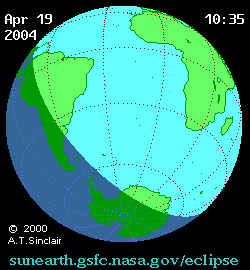Nature Partial Magnitude 0.7367 Saros 119 (65 of 71) Date 19 April 2004 | Gamma -1.1335 Greatest eclipse 13:35:05 Catalog # (SE5000) 9517 | |
 | ||
Other Instances Solar eclipse of April 8 - 2, Solar eclipse of July 2 - 20, Solar eclipse of August 2, Solar eclipse of March 9, Solar eclipse of March 20 | ||
A partial solar eclipse took place on Monday, 19 April 2004. A solar eclipse occurs when the Moon passes between Earth and the Sun, thereby totally or partly obscuring the image of the Sun for a viewer on Earth. A partial solar eclipse occurs in the polar regions of the Earth when the center of the Moon's shadow misses the Earth. It was largely visible over the south Atlantic Ocean and north shores of Antarctica, most prominently the Antarctic Peninsula. The eclipse was deep enough to be seen from a large portion of southern Africa, with over 50% totality at Cape Town, South Africa approximately 4:10 PM. However, the eclipse remained visible to cities such as Harare, Maseru, Durban, and Bloemfontein, although to a much lesser extent.
Contents
The greatest eclipse of the Sun took place over a nigh inaccessible strip of ocean off the Antarctic coast; the maximum point displayed 73.5% totality, as compared to Cape Town's 51% totality.
Images
Animated eclipse path
Solar eclipses 2004–2008
Each member in a semester series of solar eclipses repeats approximately every 177 days and 4 hours (a semester) at alternating nodes of the Moon's orbit.
Metonic series
The metonic series repeats eclipses every 19 years (6939.69 days), lasting about 5 cycles. Eclipses occur in nearly the same calendar date. In addition the octon subseries repeats 1/5 of that or every 3.8 years (1387.94 days).
